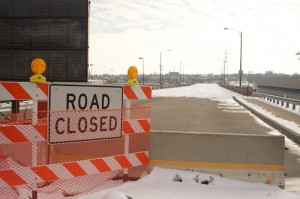With the general contracting firm already been given the notice to proceed on the project, the long-awaited reconstruction of the Grand Boulevard Bridge will begin with the aging viaduct’s closure in the first week of March, according to the St. Louis City Board of Public Service.

Before St. Louis-based Kozeny-Wagner Inc. can begin tearing down the Grand Bridge, however, one of the primary detour routes, the Compton Avenue Bridge, must first reopen, which Richard Bradley, St. Louis City’s chief engineer, said is expected to be Feb. 15.
The bridge on Compton Ave. has been closed since October of last year for needed repairs in anticipation for the 14-month closure of Grand Blvd., one of the city’s primary North-South routes.
“Once [Compton] reopens, we will post the detour signs and give drivers about two weeks to get oriented to their new routes,” Bradley said.
When the Grand Bridge closes in five weeks, the 30,000 drivers who use the bridge each day will be forced to find alternative routes. Besides Compton Ave. to the east of the bridge, Vandeventer Ave. to the west will likely be a commonly used detour route.
St. Louis Mayor Francis Slay pointed to the I-64 reconstruction project as an example of City commuters being able to deal with large transportation projects.
“City residents are resilient. They like to see investment and improvement. We don’t expect [The Grand Bridge project] to be any different,” Slay said.
Besides traffic and rerouting concerns, other challenges for the project still remain.
“The top challenge on this project is the demolition of the existing structures and building of the new viaduct that will occur over four live Metro and Union Pacific Railroad tracks,” said Patrick Kozeny, President of Kozeny-Wagner.
Another challenge for Kozeny’s construction team will be relocating a 30-inch water main that travels underneath the live tracks.
But despite these challenges, Slay and others said they remain optimistic about the bridge’s future impact on the Midtown neighborhood.
“Grand is one of the major North-South thoroughfares in the City,” Slay said, “and the bridge’s improvements will make Grand safer for people who walk or bike across the bridge, as well as for drivers or transit users.”
Junior Lauren MacDonald agreed that the bridge will be worth the wait.
“Anything is better than what we have now,” MacDonald, an avid bicyclist, said.
Once the bridge on Grand reopens in May of 2012, it will lose two traffic lanes but gain separate bike and drop-off lanes. Other improvements will include lighting and safety enhancements as well as a new MetroLink station.
Contrary to previous arrangements, Metro officials said they have decided to keep the Grand MetroLink station open, but it will only be accessible by bus or shuttle service.
The on and off ramps for I-64 will also remain open for the duration of the project.
“I think it’s going to be a mess,” said senior Julia Grawe. “It already takes me close to 20 minutes to get from the Frost Campus to the South Campus and the bridge hasn’t even closed yet.”
The University has been preparing for the construction. “Because the City’s Grand Bridge Project start date has yet to be finalized, it is more important than ever that you follow the existing guidelines offered by Academic Advising to allow at least 45 minutes between classes when traveling between campuses. We know that even with out best efforts, the project will create disruptions,” The University said in a statement. “Please know that Saint Louis University is doing everything we can to minimize the disruption including relocating core classes onto the Health Sciences Campus, enhancing SLU’s shuttle service, and developing a web site to keep you up-to-date once the project begins.”
The University recommends that if students have further questions or suggestions, they are asked to send them to the Grand Bridge Ad Hoc Committee at grandbridge@slu.edu.










